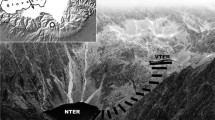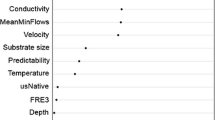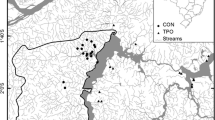Abstract
Emerging insects are important nutrient vectors for lake-to-land linkages, but they are affected by fish predation. We manipulated the fish density in four high altitude lakes in connection with a brook trout eradication project. We used a paired benthic and surface funnel trap design to test whether fish density affects abundance, size, and proportion of aquatic insects reaching the surface in the pelagic zone. The study was complemented with benthic macroinvertebrates and fish diet data. Due to sample size, we focused on midge pupae, which rely on water surface tension (water–air interface) to emerge. Conspicuous insects emerging along the shoreline (water–land interface) were rarely collected in the traps, even if they rapidly recovered through the eradication. There was a positive relationship between fish density and midge abundance, and negative relationship for size and proportion reaching the surface. The increase in the emergence of midges in the presence of fish supports several other studies, but we have provided evidence that this pattern exists in conjunction with a size reduction even when fish consume a substantial amount of midges. The inclusion of small Diptera emergence at the water–air interface is a likely keystone in understanding fish impact on insect subsidy.


Similar content being viewed by others
References
Armitage, P. D., L. C. Pinder & P. Cranston, 2012. The Chironomidae: Biology and Ecology of Non-biting Midges. Springer, Berlin.
Bates, D. M., 2013. Linear Mixed Model Implementation in lme4. University of Wisconsin, Madison.
Benjamin, J. R., K. D. Fausch & C. V. Baxter, 2011. Species replacement by a nonnative salmonid alters ecosystem function by reducing prey subsidies that support riparian spiders. Oecologia 167: 503–512.
Blumenshine, S. C., D. M. Lodge & J. R. Hodgson, 2000. Gradient of fish predation alters body size distributions of lake benthos. Ecology 81: 374–386.
Campaioli, S., P. F. Ghetti & A. Minelli, 1994. Manuale per il riconoscimento dei macroinvertebrati delle acque dolci italiane. Provincia autonoma di Trento, Trento.
Carlisle, D. M. & C. P. Hawkins, 1998. Relationships between invertebrate assemblage structure, 2 trout species, and habitat structure in Utah mountain lakes. Journal of the North American Benthological Society 17: 286–300.
Crawley, M. J., 2012. Proportion data. In Crawley, M. J. (ed.), The R Book. Wiley, Hoboken: 569–591.
Davies, I. J., 1980. Relationships between dipteran emergence and phytoplankton production in the Experimental Lakes Area, northwestern Ontario. Canadian Journal of Fisheries and Aquatic Sciences 37: 523–533.
Davies, I. J., 1984. Sampling aquatic insect emergence. In Downing, J. A. & F. H. Rigler (eds), A Manual on Methods for the Assessment of Secondary Productivity in Fresh Water. Blackwell Scientific Publications, Oxford: 161–227.
Eby, L. A., W. J. Roach, L. B. Crowder & J. A. Stanford, 2006. Effects of stocking-up freshwater food webs. Trends in Ecology and Evolution 21: 576–584.
Epanchin, P. N., R. A. Knapp & S. P. Lawler, 2010. Nonnative trout impact an alpine-nesting bird by altering aquatic-insect subsidies. Ecology 91: 2406–2415.
Fairchild, W. L., D. C. Muir, R. S. Currie & A. L. Yarechewski, 1992. Emerging insects as a biotic pathway for movement of 2, 3, 7, 8-tetrachlorodibenzofuran from lake sediments. Environmental Toxicology and Chemistry 11: 867–872.
Finlay, J. C. & V. T. Vredenburg, 2007. Introduced trout sever trophic connections in watersheds: consequences for a declining amphibian. Ecology 88: 2187–2198.
Flannagan, J. F. & G. H. Lawler, 1972. Emergence of caddisflies (Trichoptera) and mayflies (Ephemeroptera) from Heming lake, Manitoba. The Canadian Entomologist 104: 173–183.
Fukui, D. I., M. Murakami, S. Nakano & T. Aoi, 2006. Effect of emergent aquatic insects on bat foraging in a riparian forest. Journal of Animal Ecology 75: 1252–1258.
Gilinsky, E., 1984. The role of fish predation and spatial heterogeneity in determining benthic community structure. Ecology 65: 455–468.
Gratton, C., J. Donaldson & M. J. Vander Zanden, 2008. Ecosystem linkages between lakes and the surrounding terrestrial landscape in northeast Iceland. Ecosystems 11: 764–774.
Gruenstein, E., 2014. The Response of Bats to Introduced Trout in Naturally Fishless Lakes of the Sierra Nevada, California. Master Thesis, Department of Biological Sciences, San José State University, San José, CA.
Hamilton, A. L., 1965. An Analysis of a Freshwater Benthic Community with Special Reference to the Chironomidae. PhD dissertation, University of British Columbia, Vancouver, British Columbia.
Hortal, J., J. C. Nabout, J. Calatayud, F. M. Carneiro, A. Padial, A. Santos, T. Siqueira, F. Bokma, L. M. Bini & M. Ventura, 2014. Perspectives on the use of lakes and ponds as model systems for macroecological research. Journal of Limnology 73: 46–60.
Iwakuma, T., 1992. Emergence of Chironomidae from the shallow eutrophic Lake Kasumigaura, Japan. Hydrobiologia 245: 27–40.
Iwakuma, T. & M. Yasuno, 1983. Fate of the univoltine chironomid, Tokunagayusurika akamusi (Diptera: Chironomidae), at emergence in Lake Kasumigaura, Japan. Archiv für Hydrobiologie 99: 37–59.
Joseph, M. B., J. Piovia-Scott, S. P. Lawler & K. L. Pope, 2011. Indirect effects of introduced trout on Cascades frogs (Rana cascadae) via shared aquatic prey. Freshwater Biology 56: 828–838.
Knapp, R. A. & K. R. Matthews, 1998. Eradication of nonnative fish by gill netting from a small mountain lake in California. Restoration Ecology 6: 207–213.
Knapp, R. A., K. R. Matthews & O. Sarnelle, 2001. Resistance and resilience of alpine lake fauna to fish introductions. Ecological Monograph 71: 401–421.
Knapp, R. A., C. P. Hawkins, J. Ladau & J. G. McClory, 2005. Fauna of Yosemite National Park lakes has low resistance but high resilience to fish introductions. Ecological Application 15: 835–847.
Knight, T. M., M. W. McCoy, J. M. Chase, K. A. McCoy & R. D. Holt, 2005. Trophic cascades across ecosystems. Nature 437: 880–883.
Lawler, S. P. & K. L. Pope, 2006. Non-native fish in mountain lakes: effects on a declining amphibian and ecosystem subsidy. University of California Water Resources Center, Davis.
Leavitt, P. R., D. E. Schindler, A. J. Paul, A. K. Hardie & D. W. Schindler, 1994. Fossil pigment records of phytoplankton in trout-stocked alpine lakes. Canadian Journal of Fisheries and Aquatic Sciences 51: 2411–2423.
Matthews, K. R. & R. A. Knapp, 2002. Garter snake distributions in high-elevation aquatic ecosystems: is there a link with declining amphibian populations and nonnative trout introductions? Journal of Herpetology 36: 16–22.
Nayar, J. K. & A. Ali, 2003. A review of monomolecular surface films as larvicides and pupicides of mosquitoes. Journal of Vector Ecology 28: 190–199.
Nakano, S. & M. Murakami, 2001. Reciprocal subsidies: dynamic interdependence between terrestrial and aquatic food webs. Proceeding of the National Academy of Sciences 98: 166–170.
Pinheiro, J. & D. Bates, 2006. Mixed-effects models in S and S-PLUS. Springer Science & Business Media, Berlin.
Pope, K. L., J. Piovia-Scott & S. P. Lawler, 2009. Changes in aquatic insect emergence in response to whole-lake experimental manipulations of introduced trout. Freshwater Biology 54: 982–993.
Power, M. E. & W. E. Rainey, 2000. Food webs and resource sheds: towards spatially delimiting trophic interactions. In Hutchings, M. J., M. J. John & A. J. A. Stewart (eds), The Ecological Consequences of Environ mental Heterogeneity. Blackwell Science, Malden: 291–314.
R Development Core Team, 2013. R: A Language and Environment for Statistical Computing. R Foundation for Statistical Computing. Vienna, Austria. http://www.R-project.org/. Accessed 1 September 2015.
Tiberti, R., E. Acerbi & R. Iacobuzio, 2014a. Preliminary studies on fish capture techniques in Gran Paradiso alpine lakes: towards an eradication plan. Journal of Mountain Ecology 9: 61–74.
Tiberti, R., A. von Hardenberg & G. Bogliani, 2014b. Ecological impact of introduced fish in high altitude lakes: a case of study from the European Alps. Hydrobiologia 724: 1–19.
Tiberti, R., S. Brighenti, C. Canedoli, R. Iacobuzio & M. Rolla, 2016. Factors influencing the diet of introduced brook trout (Salvelinus fontinalis; Mitchill, 1814) in an Alpine area. Journal of Limnology, in press.
Tiberti, R., G. A. Tartari & A. Marchetto, 2010. Geomorphology and hydrochemistry of 12 Alpine lakes in the Gran Paradiso National Park, Italy. Journal of Limnology 69: 242–256.
Tolonen, K. T., H. Hamalainen, I. J. Holopainen, K. Mikkonen & J. Karjalainen, 2003. Body size and substrate association of littoral insects in relation to vegetation structure. Hydrobiologia 499: 179–190.
Tweedy, B. N., R. W. Drenner, M. M. Chumchal & J. H. Kennedy, 2013. Effects of fish on emergent insect-mediated flux of methyl mercury across a gradient of contamination. Environmental Science and Technology 47: 1614–1619.
Vander Zanden, M. J. & C. Gratton, 2011. Blowin’in the wind: reciprocal airborne carbon fluxes between lakes and land. Canadian Journal of Fisheries and Aquatic Sciences 68: 170–182.
Vinson, M. R., E. C. Dinger & D. K. Vinson, 2010. Piscicides and invertebrates: after 70 years, does anyone really know? Fisheries 35: 61–71.
Wissinger, S. A., A. R. Mcintosh & H. S. Greig, 2006. Impacts of introduced brown and rainbow trout on benthic invertebrate communities in shallow New Zealand lakes. Freshwater Biology 51: 2009–2028.
Zuur, A. F., E. N. leno, N. J. Walker, A. A. Saveliev & G. M. Smith, 2009. Mixed effects models and extensions in ecology with R. Springer Science & Business Media, New York.
Acknowledgments
The authors would like to thank Bruno Bassano, Achaz von Hardenberg (GPNP) and Giuseppe Bogliani (University of Pavia) for their commitment to research in the GPNP, and two anonymous reviewer for their constructive comments. Special thanks to the Park wardens for their help and hospitality, to Stefano Malaguti, Giovanni Cecioni, Jean Laurant Jordaney, Kevin Liautaud, Andreu Porcar, Gioele Grandi for their help during the field work, and to Ben T. Jennings and Mia Berwick for their kind linguistic revision. Funding and logistic support for this research was provided by the GPNP within the framework of the LIFE + project BIOAQUAE (Biodiversity Improvement of Aquatic Alpine Ecosystems, LIFE11 BIOIT000020). All field work was performed under licenses from the GPNP and approved by the Istituto Superiore per la Protezione e la Ricerca Ambientale (ISPRA). Permissions for fishing activities have been issued by the GPNP (protocol number 1798/1013/BB) with the favorable opinion of ISPRA (Istituto Superiore per la Protezione e Ricerca Ambientale, protocol number 0017655—29/04/2013).
Author information
Authors and Affiliations
Corresponding author
Additional information
Handling editor: John M. Melack
Electronic supplementary material
Below is the link to the electronic supplementary material.
Rights and permissions
About this article
Cite this article
Tiberti, R., Rolla, M., Brighenti, S. et al. Changes in the insect emergence at the water–air interface in response to fish density manipulation in high altitude lakes. Hydrobiologia 779, 93–104 (2016). https://doi.org/10.1007/s10750-016-2801-z
Received:
Revised:
Accepted:
Published:
Issue Date:
DOI: https://doi.org/10.1007/s10750-016-2801-z




